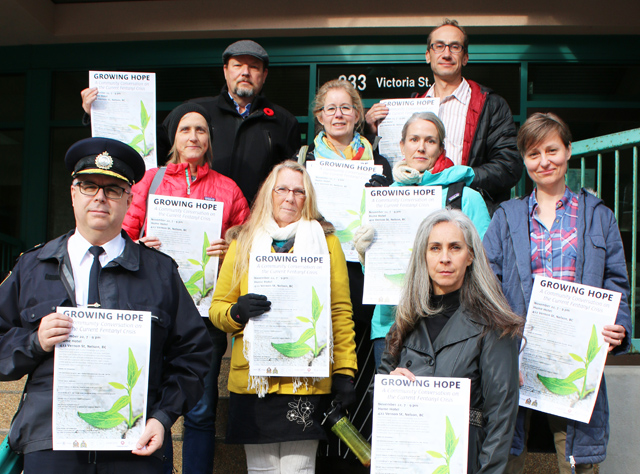Fentanyl Task Force Leads Way Through Conversation
Experts agree the fentanyl crisis in British Columbia is an unprecedented multi-faceted societal catastrophe that’s not going away anytime soon. Those on the frontlines are also united in recognizing that solutions will only be possible through education and conversation.
As health care professionals, emergency responders, educators and community leaders across the West Kootenay continue to combat the devastating human toll the drug is taking on the region, Nelson’s Fentanyl Task Force is reaching out through education. On November 22, the education and prevention sub-committee of the task force is hosting Growing Hope: A Community Conversation on the Current Fentanyl Crisis at Nelson’s Hume Hotel.
“What will have the biggest effect on death is reducing stigma for people who are using drugs,” says Chole Sage, an educator at Nelson’s ANKORS who will be part of a seven-person panel of speakers at the event. “One of the goals of these panels is to be able to talk about all the issues that involve people who use drugs and people who are at risk of dying from fentanyl overdose. When we start lowering the stigma and people can talk about what they are going through, then we will have less deaths because people will be able to seek the help they need.”
Joining Sage on the panel will be nurse practitioner Zak Matieschyn, Interior Health mental health educator Karen Leman, Freedom Quest Youth Services Society representative Julia Webb, Nelson Street Outreach worker Jeremy Kelly, and Sean and Pat Dooley who will share their personal experience with addiction.
The Growing Hope event is one of several initiatives being undertaken by the task force that was formed last November by Nelson Police Department Chief Paul Burkart who helped pull together more than 40 individuals actively working on dealing with the issue. The public is invited to come hear experts who have knowledge and direct experience with opioid substance use. There will be an opportunity to ask questions in an effort to strengthen communities and protect people who are vulnerable.
“Much of the fentanyl crisis has to do with trauma, drug use, poverty and homelessness,” says Burkart, who has been with the local police force for 17 years. “We’re not going to solve those things in the next six months. What we need to do is respond to the problem right now and a vital part of that is harm reduction.”
From Education Comes Solutions
Selkirk College Nursing Program instructor Tammy McLean has been involved in the health care profession for more than three decades in hospitals, intensive care units, palliative care and as a post-secondary educator. A member of the education and prevention sub-committee of the task force, McLean says the fentanyl crisis is one of the most troubling issues she has seen in her career.
“What we are seeing is unprecedented,” says McLean, who has worked as a Selkirk College instructor since 2008. “We are on target to seeing upwards of 1,500 people in our province dying because of opioids this year. If you compare it to a plane crash with airplanes filled with 375 people each, there are going to be four planes falling from the sky and everyone on board dying. That’s the equivalent of what’s going on right now. We need to have a multi-pronged approach to this.”
Selkirk College has been running the Street Nursing Program in Nelson for more than a decade. Third and fourth year students completing their Bachelor of Nursing degree work with marginalized people who are homeless, living in shelters or are at the risk of being homeless. Struggles with substance abuse compounds the plight of the individuals that students connect with on a regular basis, so having the college as part of the conversation is an important element of the education.
“We want to be really good community partners, working with local businesses and service providers in caring for our communities,” says McLean. “The vast majority of our students come from our local communities and they have a vested interest in the health of our communities as well. It’s a natural fit that we are part of it and representing Selkirk College.”
Students involved in the Street Nursing Program bring a non-judgemental lens to the work they do on an annual basis which is vital for breaking down stigma.
“Meeting people where they are at means they may still be using substances, but we want to make sure they are safe in how they are using them,” says McLean. “If we can keep them safe, keep them alive—particularly with fentanyl—then potentially we can support them in different ways to maybe get them off the streets and maybe find employment, maybe reconnect with the health care system. And even if we don’t do that, at least we can be a compassionate person for where they are at. Having addictions is hellish and we just need to meet them where they are at to provide a good human face.”
Harm Reduction Helps Stem Epidemic
ANKORS (AIDS Network, Outreach & Support Society) has been an active part of responding to the needs of community members for 25 years. Harm reduction is an important element of the Nelson-based organization’s mandate and Sage is one of the region’s leading experts in the field. Like most others, the veteran educator is overwhelmed by the current crisis.
“The numbers of deaths that are happening is astounding,” says Sage. “It’s quite traumatic for us as frontline workers to be seeing so much death, more than we have ever seen before. This is an eye into drug dependency: they are terrified of dying every time they self-medicate yet they do it anyway because they will get sick if they don’t. This is a very stressful place to be.”
One of the most pressing discussions that needs to take place in regards to fentanyl has little connection to street culture. Of the target demographics for the Growing Hope event is parents and youth who don’t think that the crisis impacts them. This is where proper information and resources become an essential part of the conversation.
“Many people are dying who are dependent on drugs, but there’s also a lot of people dying who are experimenting with drugs,” says Sage. “This is the most dangerous time in history to experiment with substances, yet people are still doing it. Youth are still doing it. All through history, no matter what we have said to youth… they are still doing it. Our approach to this has to be one of harm reduction, it has to be one where we are able to openly talk about drug use without there being the stigma and judgement and ‘just say no’ because ‘just say no’ has never worked.”
It’s not the most comfortable conversation to have.
“It’s always going to be there, we are not going to end people using drugs, ever,” says Sage. “We have to look at it in a way that is realistic and for me educating the youth about what drugs are out there and what strengths and what things can be most dangerous if you mix them, what are some ways you can use safer… those are the kind of things that people who are already choosing to use drugs may save their lives. But if we just say no and they are going use anyways, they won’t know the information that will help them to be safer.”
Another barrier to finding solutions is ignoring the problem or not recognizing that those who are addicted have the same right to opportunity as everyone else.
“If people could just try to see people with whole stories rather than just see the addiction,” says Sage. “When people call people addicts, they are labeling them as the dependency to the drugs. They are many things other than that and each person in the world deserves to be seen as a whole person, a person with passions, a person who has people that love them, a person who loves other people. That’s when we start to see them as other human beings.”
Moving Forward Instead of Standing Still
The current crisis has many layers and the underlying issues are complex. There’s only so much local initiatives like the Fentanyl Task Force can realistically accomplish without support from senior levels of government. Proper housing, social services and health care require provincial and federal dollars to really make an impact.
When he talks to colleagues in other communities across the province, Chief Burkart says the situation in the West Kootenay is not unique and is on par with larger centres. Instead of getting in line, he says the support the task force has received from the community at a grassroots level provides the region with an advantage.
“We have to do something or the numbers will continue to increase every year,” says Chief Burkart. “We wouldn’t have these committees if we didn’t think there is going to be an impact. It’s multi-faceted and can seem overwhelming, but it’s important that we take it on.”
Talking about it with friends, neighbours and loved ones is what will provide those on the frontlines with a glimmer of light that better days are ahead.
“I’m hopeful because this is really based on coming from a place of hope and not despair,” says McLean. “Yes, things are bad and we have lost people in our communities. But there is still lots we can do to support each other and when you come from that place, there is optimism that we can maybe turn a corner on this. It won’t happen tomorrow and it’s not a quick fix, but we’re on the path and it’s a Made in the Kootenays solution.”
Growing Hope: A Community Conversation on the Current Fentanyl Crisis at Nelson’s Hume Hotel will take place between 7 p.m. and 9 p.m. on November 22. Organizers of the event are asking people to think ahead of time about their questions for the question and answer portion of the evening, which will be collected in written form during the event and posed to the panel. Doors open at 6:30 p.m., seating is limited.
Funding for the event was made possible through the Community Action Initiative and the Centre for Addiction Research of BC.


























